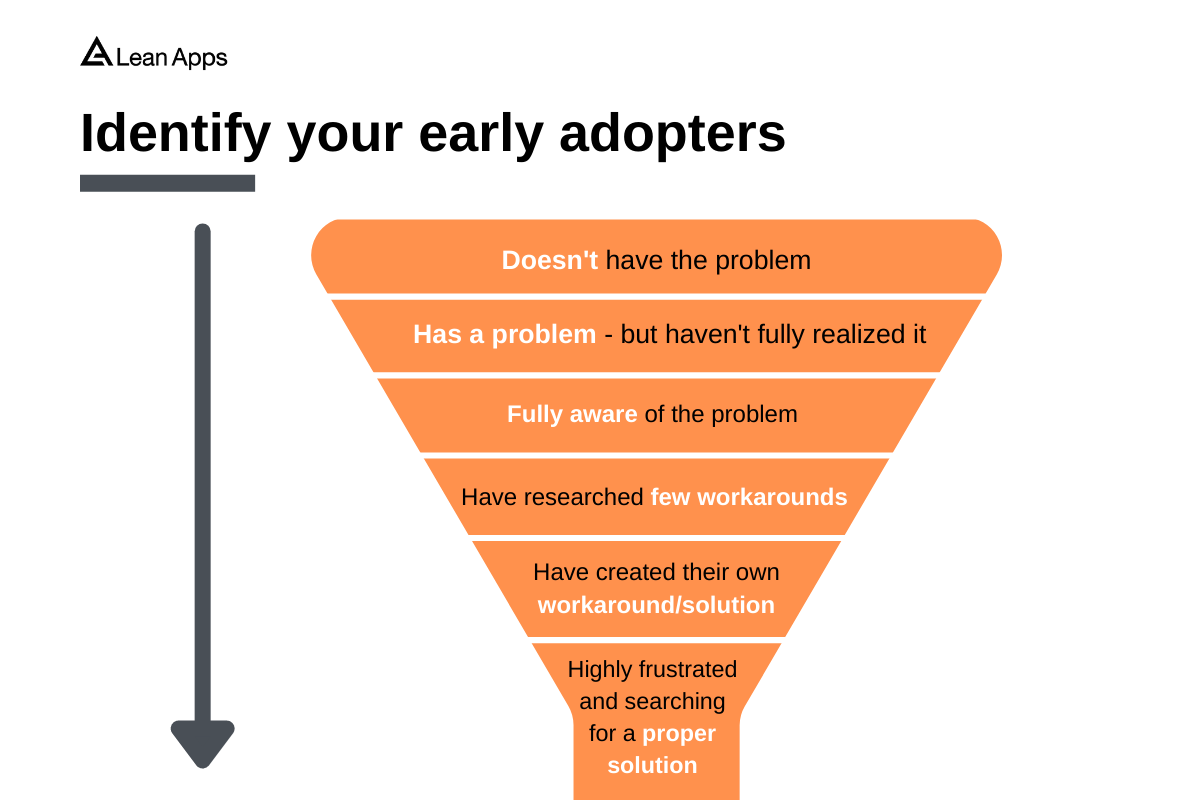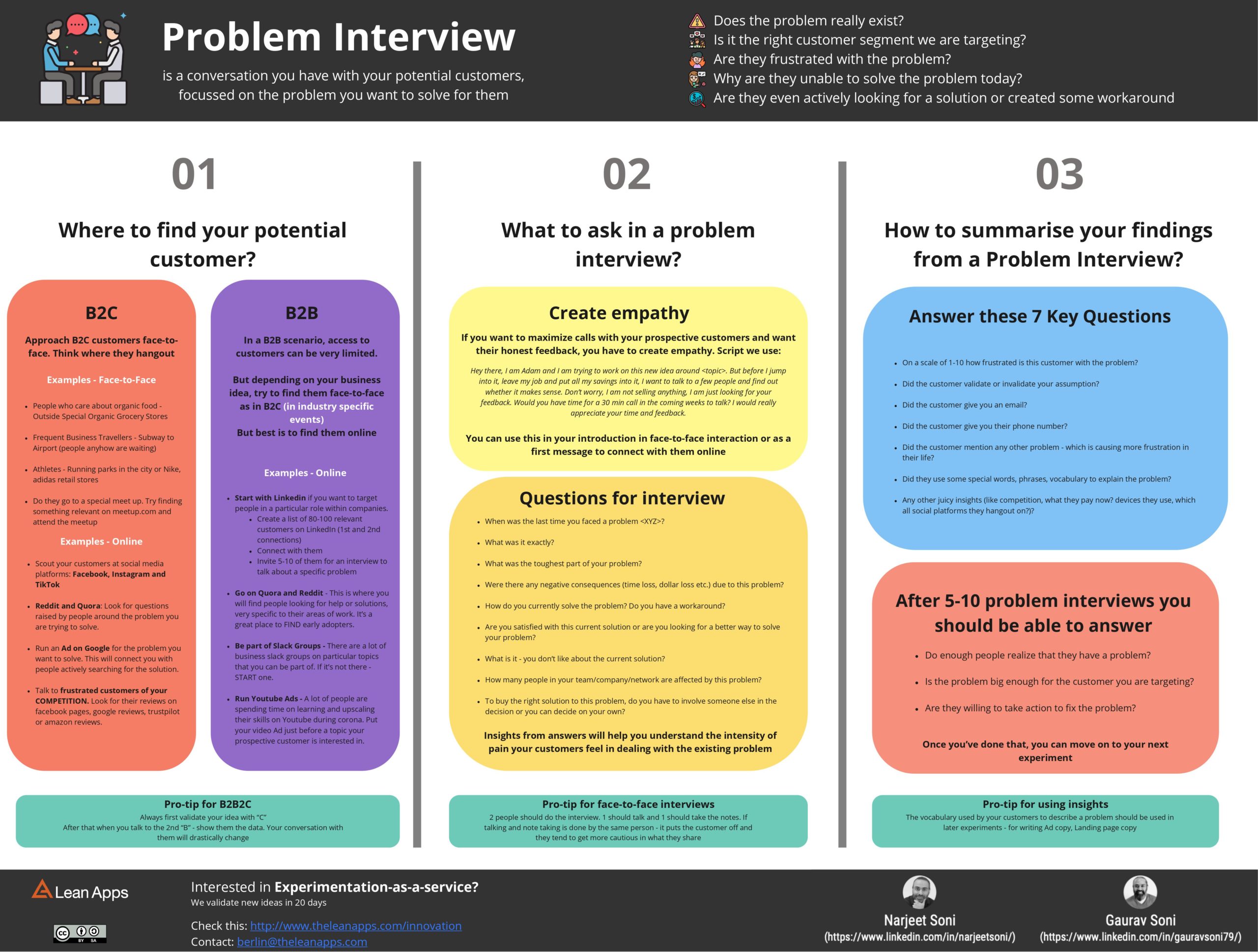Are your customers telling you their problems?
03 June 2021
Are you solving the right problem? Not sure.
Are you targeting the right customer? Not sure.
All you’ve got is an idea? Yes.
Then it’s time to get started with Problem Interviews.
What is a problem interview though?
It’s a conversation you have with your potential customer about the problem you want to solve for them.
The goal is to find out:
- Does the problem really exist?
- Is it the right customer segment we are targeting?
- Are they frustrated with the problem?
- Why are they unable to solve the problem today? (Are they even actively looking for a solution or created some workarounds?)
Where to find your potential customers?
If your business model is B2C – you can approach customers face-to-face. Think about where they hang out.
Some places we have targeted in the past:
- People who care about organic food – Outside Special Organic Grocery Stores
- Frequent Business Travellers – Subway to Airport (people anyhow are waiting)
- Golfers – Inside and outside of golf retail shops
- Photographers – inside and outside of electronic retail shops that specialize in lenses
- Foreign Tourists in the city – Near famous tourist spots or restaurants famous in that city on TripAdvisor or people who take free tours – join one of them
- Athletes – Running parks in the city or Nike, Adidas retail stores
- Writers – Writing meetups in the city (Find them on meetup.com)
- People that own more than 1 apple device – Outside apple stores (they are also waiting in the queue)
- Diabetic patients – Outside diabetic clinics (similarly find the other specialized clinics depending on the patient type you are targeting)
During corona, the face-to-face interactions have not been easy. But the good thing is people are spending more time online. So we have been successful in reaching out to B2C customers on different social media platforms: Facebook, Instagram, and TikTok.
Another good option to find people is by hunting for people on Reddit and Quora. Look for questions raised by people around the problem you are trying to solve.
Running an Ad on Google for the problem you want to solve can connect you with people actively searching for the solution.
Lastly, frustrated customers of your competition are always good to talk to. Look for online reviews left by frustrated customers of your competition and try and stalk them online to get on a call. These reviews are usually on their Facebook page, Google reviews, Trustpilot, or Amazon reviews.
B2B is much harder.
In a B2B scenario, your access to customers will be very limited. But depending on your business idea – you can also hunt them. Here are few ways we make it possible:
- Linkedin: This is best if you want to target people or a particular role within companies. You create a list of 80-100 relevant customers on LinkedIn, connect with them. And invite 5-10 of them for an interview to talk about a specific problem.
- Quora and Reddit: You can use this too in B2B scenarios. This is where you will find people looking for help or solutions, very specific to their areas of work. It’s a great place to find early adopters.
- Slack Groups: There are a lot of business slack groups on particular topics that you can be part of. If it’s not there – start one.
- Youtube Ads: A lot of people are spending time on learning and upscaling their skills on Youtube during corona. Putting your content just before a topic your prospective customer is interested in – would definitely be a win
Tip: For B2B2C – always first validate with “C” and when you talk to the 2nd “B” – show them the data. Your conversation with them will drastically change 😇
Next step – invite them for a problem interview.
How to invite them to talk to you?
If you want to maximize calls with your prospective customers and want their honest feedback, you have to create empathy. Here is a script we use:
Hey there, I am Adam and I am trying to work on this new idea around <topic>. But before I jump into it, leave my job and put my savings into it, I want to talk to a few people and find out whether it makes sense. Don’t worry, I am not selling anything, I am just looking for your feedback.
Would you have time for a 30 min call in the coming weeks to talk? I would really appreciate your time and feedback.
Sometimes I also add:
I have a 3 year old and a 5 year old at home
You can use this in your face-to-face interaction or as a first message to approach them to talk to them.
What to ask during the interview?
Start with a casual chit-chat and thank them for their time. Tell them who you are and why you are interviewing them. And that you have a set of questions that you would like to ask.
Start with basic questions around the problem:
- When was the last time you faced a problem <XYZ>?
- What was it exactly?
- What was the toughest part of your problem?
- Were there any negative consequences (time loss, dollar loss etc.) due to this problem?
- How do you currently solve the problem? Do you have a workaround?
- Are you satisfied with this current solution or are you looking for a better way to solve your problem?
- What is it – you don’t like about the current solution?
- How many people in your team/company/network are affected by this problem?
- To buy the right solution to this problem, do you have to involve someone else in the decision or you can decide on your own?
Insights from these questions will help you understand the intensity of pain your customers feel in dealing with the existing problem.
It will also help you hone the customer segment and identify early adopters:
Some interview tips you can follow to maximize your learning:
1. Don’t Pitch! Don’t try and sell your solution. Ask questions that lead to a dialogue. Allow the customer to talk about their preferences. Ask them why? How?
2. Observe user behavior, not opinion. Watch their body language. Look for how they talk and behave while explaining the problem. Inspect their emotions and body language as they talk. Pick on the things they talk passionately about. That’s where you’ll find your answers.
3. Concentrate on Past/Present, not future. Try and get the customers to talk about their past and present experiences rather than what they anticipate in future.
4. Don’t preach. Never ever take on the expert mode and start explaining/preaching things to the customer. Let the customer talk even if he or she wants to go off topic.
5. Listen carefully: Give nonverbal cues such as a little head nod or smile to show that you are following what the customers are saying. Typing notes on to your laptop is a big NO. It will completely throw the customer off. If need be, make notes on paper or record the interview if the customer feels comfortable.
Collect Skin in the game
Anything that your customers value and are willing to part with is considered skin in the game. Initially, it could be as little as a VALID email address (company email is even better) or a phone number from a customer.
Tell them clearly you will be using this to contact them about product updates and once it’s ready for a product demo.
Customers should share something more than just an opinion.
Remember: “It’s easy to get people to open their mouths, but not their wallets.”
After the interview
Summarize your interview finding in quantitative and qualitative feedback. Answer these questions :
- On a scale of 1-10, how frustrated is this customer with the problem?
- Did the customer validate or invalidate your assumption?
- Did the customer give you an email?
- Did the customer give you the phone number?
- Did the customer mention any other problem – which is causing more frustration in their life?
- Did they use some special words, phrases to explain the problem?
- Any other juicy insights (like competition, what they pay now? devices they use, which all social platforms they hangout on?)
At the end of the day, after doing 5-10 customer interviews you should be able to draw a pattern and should be able to answer:
- Do enough people realize that they have a problem?
- Is the problem big enough for the customer you are targeting?
- Are they willing to take action to fix the problem?
Once you’ve done that, you can move on to your next experiment.
Don’t forget to download the most important cheat-sheet on Problem Interview here





